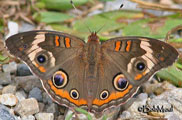Native Plants
Search for native plants by scientific name, common name or family. If you are not sure what you are looking for, try the Combination Search or our Recommended Species lists.
Verbena hastata
Verbena hastata L.
Swamp Verbena, Blue Verbena, Blue Vervain, Simpler's Joy
Verbenaceae (Verbena Family)
Synonym(s):
USDA Symbol: VEHA2
USDA Native Status: L48 (N), CAN (N)
Simplerís Joy or Blue Verbena is a 2-6 ft., stout-stemmed perennial with numerous, pencil-like flower spikes branched upwards like the arms of a candelabra. Each flower spike has a ring of blue-purple flowers; the flowers at the bottom of the spike bloom first, and the ring of flowers appears to advance upward to the tips of the spike. The stiff, pencil-like spikes are at the top of a square, grooved stem and its branches.
This species is a member of the verbena family (family Verbenaceae), which includes about 75 genera and 3,000 species of herbs, shrubs, and trees, mostly of tropical and warm temperate regions. Among them, teak is a highly prized furniture wood, and Vervain, Lantana, Lippia or Frog Fruit, and Chase Tree or Vitex are grown as ornamentals.
Bumblebees are among the important pollinators. In ancient times the plant was thought to be a cure-all among medicinal plants and the genus name is Latin for "sacred plant." Hoary Vervain (V. stricta), to 10 feet (3 m) tall and with flowers 1/2-inch (1.3 cm) long, is most abundant in the Midwest and occurs sporadically eastward. Narrow-leaved Vervain (V. simplex), has narrow leaves and lavender flowers 1/3 of an inch (8 mm) long; it is a southwestern and midwestern species.
Plant Characteristics
Duration: BiennialHabit: Herb
Fruit Type: Schizocarp
Size Notes: Up to about 6 feet tall.
Bloom Information
Bloom Color: Blue , PurpleBloom Time: Jun , Jul , Aug , Sep , Oct
Distribution
USA: AL , AR , AZ , CA , CO , CT , DC , DE , GA , IA , ID , IL , IN , KS , KY , LA , MA , MD , ME , MI , MN , MO , MS , MT , NC , ND , NE , NH , NJ , NM , NV , NY , OH , OK , OR , PA , RI , SC , SD , TN , TX , UT , VA , VT , WA , WI , WV , WYCanada: BC , MB , NB , NS , ON , QC , SK
Native Distribution: N.S. to B.C., s. to FL, KS, NM & CA
Native Habitat: Moist prairies; damp thickets.
Growing Conditions
Light Requirement: Sun , Part Shade , ShadeSoil Moisture: Moist , Wet
Soil Description: Moist soils.
Benefit
Use Wildlife: Attracts bees.Use Medicinal: This plant has been used for many years as a medicinal herb for treating convalescents and people suffering from depression, headaches, jaundice, cramps, coughs and fevers. Externally, it has been applied to wounds, ulcers and acne. Swamp vervain can, however, interere with blood pressure medication and hormone therapy, and large doses cause vomiting and diarrhea. (Kershaw)
Conspicuous Flowers: yes
Attracts: Birds , Butterflies
Larval Host: Common Buckeye
Value to Beneficial Insects
Special Value to Native BeesThis information was provided by the Pollinator Program at The Xerces Society for Invertebrate Conservation.
Butterflies and Moths of North America (BAMONA)
|
Common Buckeye (Junonia coenia)  Larval Host |
Propagation
Description: Propagate from seed.Seed Treatment: Seed requires cool-moist stratification for 30 days. After stratification, seeds can be incubated at from 60-80 degrees in the presence of light.
Commercially Avail: yes
Find Seed or Plants
Find seed sources for this species at the Native Seed Network.
National Wetland Indicator Status
| Region: | AGCP | AK | AW | CB | EMP | GP | HI | MW | NCNE | WMVE |
| Status: | FAC | FAC | FACW | FACW | FACW | FACW | FAC |
From the National Organizations Directory
According to the species list provided by Affiliate Organizations, this plant is on display at the following locations:Native Plant Center at Westchester Community College, The - Valhalla, NY
Native Seed Network - Corvallis, OR
Bibliography
Bibref 1186 - Field Guide to Moths of Eastern North America (2005) Covell, C.V., Jr.Bibref 1185 - Field Guide to Western Butterflies (Peterson Field Guides) (1999) Opler, P.A. and A.B. Wright
Bibref 946 - Gardening with Prairie Plants: How to Create Beautiful Native Landscapes (2002) Wasowski, Sally
Bibref 841 - Native Alternatives to Invasive Plants (2006) Burrell, C. C.
Bibref 1294 - The Midwestern Native Garden: Native Alternatives to Nonnative Flowers and Plants An Illustrated Guide (2011) Adelman, Charlotte and Schwartz, Bernard L.
Search More Titles in Bibliography
Web Reference
Webref 23 - Southwest Environmental Information Network (2009) SEINet - Arizona ChapterAdditional resources
USDA: Find Verbena hastata in USDA PlantsFNA: Find Verbena hastata in the Flora of North America (if available)
Google: Search Google for Verbena hastata
Metadata
Record Modified: 2023-03-01Research By: TWC Staff